| |
What were you thinking about that day, little Delilah Fern Porter? Had you ever had your picture taken
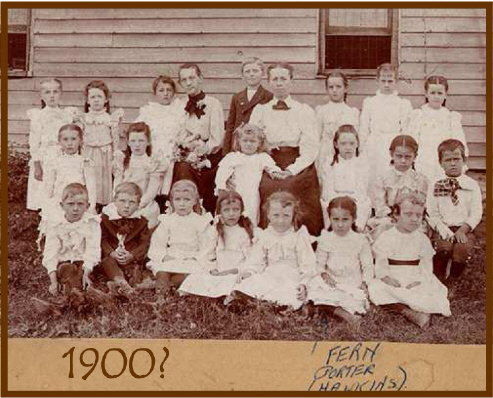 before? Were you worried about getting your pretty white dress dirty sitting on the ground? before? Were you worried about getting your pretty white dress dirty sitting on the ground?
Are you as apprehensive as you look, or did they simply tell everyone to be serious and proper for the picture? And one more question: Were you already insisting on being called Fern?
I am sure the little girl with the deep brown eyes wasn’t thinking that a hundred and ten years later a granddaughter would be studying the picture and writing about her.
We just found out this summer that the “old schoolhouse,” as we’ve always called it, actually carried one of our family names—the Porter School. We don’t have information on when it was built, but we know it
 was used as a school until 1956. We don’t know how many Porter
family members attended it, but we feel confident of at least four in this picture, plus two or three in later years, and we can conjecture about a few more. was used as a school until 1956. We don’t know how many Porter
family members attended it, but we feel confident of at least four in this picture, plus two or three in later years, and we can conjecture about a few more.
The picture of the school is from one of my grandparents’ photo books. I don’t know when our culture decided on smiling faces in pictures instead of sober
ones,* but I’m glad they did. It’s impressive that all the girls have on white, long-sleeved dresses, most in complex pinafore style. What an effort it must have taken to get sixteen little girls dressed like that for a school picture! Given Fern’s size, I estimate 1900 or 1901 as the date for the picture.
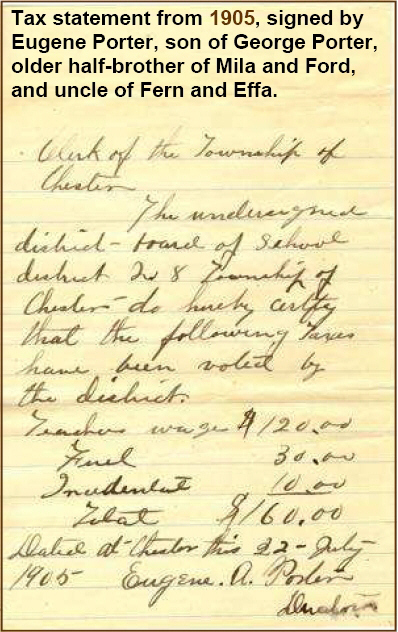 We think three other Porters besides Grandma Fern are in the picture. Her sister Effa is in the back row, far left, and we think Ford Porter and his sister Mila are on the right end of the middle row. Fern and Effa both grew up to be pastors’ wives, Mila was a school teacher and principal, and Ford became a pastor and founder of a worldwide
tract ministry. We think three other Porters besides Grandma Fern are in the picture. Her sister Effa is in the back row, far left, and we think Ford Porter and his sister Mila are on the right end of the middle row. Fern and Effa both grew up to be pastors’ wives, Mila was a school teacher and principal, and Ford became a pastor and founder of a worldwide
tract ministry.
From the Chester Township historian we now have a copy of a tax statement from 1905. Besides interesting facts such as the teachers’ salary, it is noteworthy that it was signed by one of the Porter clan. Eugene Porter was son of George Porter who had built the large farmhouse a bit further east on Truman Road.
The statement was written to the Chester Township Clerk for the purpose of setting the Township budget. Eugene was a Director
of the Porter School Board.
See the caption of the tax statement for his relationships to the four in the picture. Another possibility is that one of the older girls
is Eugene’s daughter, Delilah
Zoe, seven years older
than Fern.
In 1992 when we made our first family-history—or “ancestor”—tour, one of our stops was at the school. It was weathered, the bell was gone, and lush vines were enjoying a happy life on the outer walls, even across half the front door. We peeked in the windows but couldn’t see much. In our group that day were
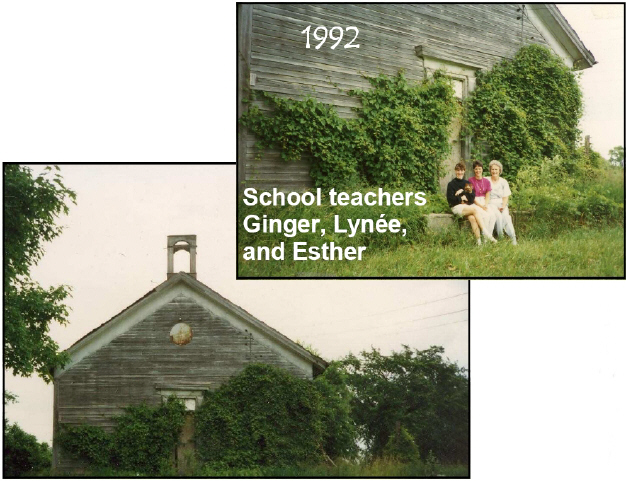
three school teachers of today’s generations—my daughter-in-law
Ginger (Gentry) Gross, daughter
Lynée Gross (now Ward), and me, so we posed for a picture sitting on what was left of the front stoop.
As we drove away down Truman Road, we didn’t know it was the last time we would see the school standing.
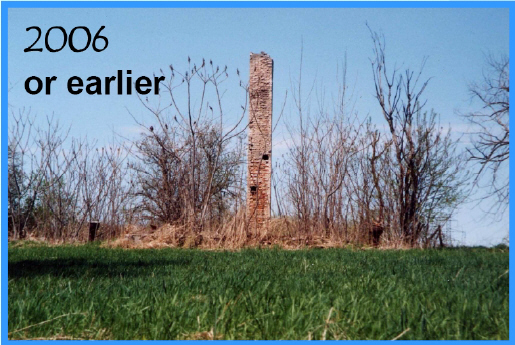 The next time we were in Michigan, we drove by—and stared. The school was gone—almost. The only thing left was the chimney. Of course we had to take a picture of it. We have conflicting reports on whether the school burned down or was torn down, but our hearts said a fond farewell.
The next time we were in Michigan, we drove by—and stared. The school was gone—almost. The only thing left was the chimney. Of course we had to take a picture of it. We have conflicting reports on whether the school burned down or was torn down, but our hearts said a fond farewell.
It turned out that wasn’t the end of our adventures with that piece of our family history. When we went
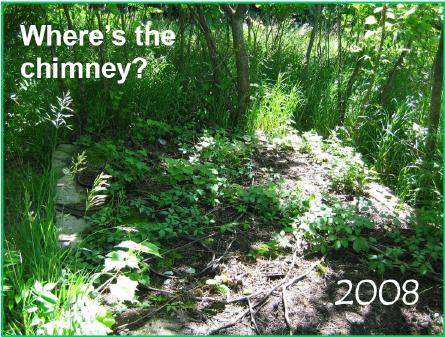 back on an ancestor trip with other family members in 2008, we had trouble identifying the spot where the school had been because even the chimney was gone. The site was surprisingly overgrown. Could the chimney still be there, we wondered, right where it fell? So my sister and my nephew
and I went tromping through the undergrowth in search of it—and we found it. After we got our pictures and picked our way back out of the underbrush, we back on an ancestor trip with other family members in 2008, we had trouble identifying the spot where the school had been because even the chimney was gone. The site was surprisingly overgrown. Could the chimney still be there, we wondered, right where it fell? So my sister and my nephew
and I went tromping through the undergrowth in search of it—and we found it. After we got our pictures and picked our way back out of the underbrush, we
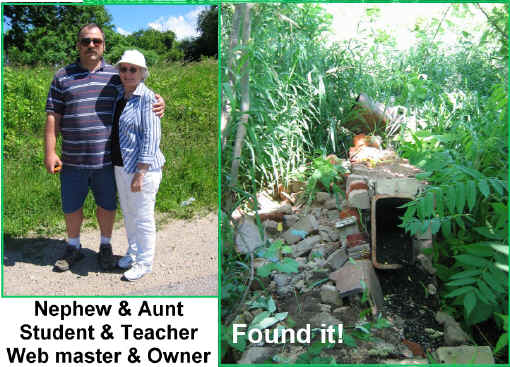 decided to take a picture of the teacher and student we had present that day—my nephew
(Matthew Hoppe) and I (Esther Moneysmith Gross). I taught him kindergarten and 7th grade in South America, and he is now the webmaster for this family history scrapbook. decided to take a picture of the teacher and student we had present that day—my nephew
(Matthew Hoppe) and I (Esther Moneysmith Gross). I taught him kindergarten and 7th grade in South America, and he is now the webmaster for this family history scrapbook.
Grandma (little Fern in the picture) grew up to live her life,
sending two daughters overseas as missionaries and her son off to war. She’s been gone almost sixty years now. It is from her side of the family that we have such a rich ancestral heritage. How I would love to spend an afternoon with her, talking about her past and my present. I would ask her how many years she attended the school and how she got to and from school, especially on icy Michigan winter days. With her
being born in 1894, I’m quite sure cars weren’t common yet. In fact, I just picked up information that even in 1909 there were only 8,000 cars in the whole country.
For my turn, I would tell her about her grandchildren and great-grandchildren who love the Lord, about the intense struggles some of them are dealing with, and how I’m sure some of the faith that sustains them had its roots in her and Grandpa. I would say I’m glad I never had to wear shoes like she has on in the picture! I might or might not tell her I still remember that she sewed my coat pockets shut when I was ten because I wouldn’t stop wearing holes through by putting my hands in them.
Something I would not do is spend time describing for her things that would leave her staring blankly at me—things like computers, cell phones, and a moon landing. No. She had a rich life in her time. I’m not going to suggest she missed out just because I’ve had some things she didn’t.
Consider, after all, that she attended a school where they went to the trouble to get all the little girls in white pinafore dresses before having a school picture taken. *I found out from the Chester Township historian the reason for the sober faces. “The photographic plate in the cameras of that era had to be exposed over a period of time. … Since it was hard for most folks to hold a steady smile for several minutes, they were all sober faced.”
|
|
 before? Were you worried about getting your pretty white dress dirty sitting on the ground?
before? Were you worried about getting your pretty white dress dirty sitting on the ground? was used as a school until 1956. We don’t know how many Porter
family members attended it, but we feel confident of at least four in this picture, plus two or three in later years, and we can conjecture about a few more.
was used as a school until 1956. We don’t know how many Porter
family members attended it, but we feel confident of at least four in this picture, plus two or three in later years, and we can conjecture about a few more.
 We think three other Porters besides Grandma Fern are in the picture. Her sister Effa is in the back row, far left, and we think Ford Porter and his sister Mila are on the right end of the middle row. Fern and Effa both grew up to be pastors’ wives, Mila was a school teacher and principal, and Ford became a pastor and founder of a worldwide
tract ministry.
We think three other Porters besides Grandma Fern are in the picture. Her sister Effa is in the back row, far left, and we think Ford Porter and his sister Mila are on the right end of the middle row. Fern and Effa both grew up to be pastors’ wives, Mila was a school teacher and principal, and Ford became a pastor and founder of a worldwide
tract ministry.
 The next time we were in Michigan, we drove by—and stared. The school was gone—almost. The only thing left was the chimney. Of course we had to take a picture of it. We have conflicting reports on whether the school burned down or was torn down, but our hearts said a fond farewell.
The next time we were in Michigan, we drove by—and stared. The school was gone—almost. The only thing left was the chimney. Of course we had to take a picture of it. We have conflicting reports on whether the school burned down or was torn down, but our hearts said a fond farewell. back on an ancestor trip with other family members in 2008, we had trouble identifying the spot where the school had been because even the chimney was gone. The site was surprisingly overgrown. Could the chimney still be there, we wondered, right where it fell? So my sister and my nephew
and I went tromping through the undergrowth in search of it—and we found it. After we got our pictures and picked our way back out of the underbrush, we
back on an ancestor trip with other family members in 2008, we had trouble identifying the spot where the school had been because even the chimney was gone. The site was surprisingly overgrown. Could the chimney still be there, we wondered, right where it fell? So my sister and my nephew
and I went tromping through the undergrowth in search of it—and we found it. After we got our pictures and picked our way back out of the underbrush, we
 decided to take a picture of the teacher and student we had present that day—my nephew
(Matthew Hoppe) and I (Esther Moneysmith Gross). I taught him kindergarten and 7th grade in South America, and he is now the webmaster for this family history scrapbook.
decided to take a picture of the teacher and student we had present that day—my nephew
(Matthew Hoppe) and I (Esther Moneysmith Gross). I taught him kindergarten and 7th grade in South America, and he is now the webmaster for this family history scrapbook.